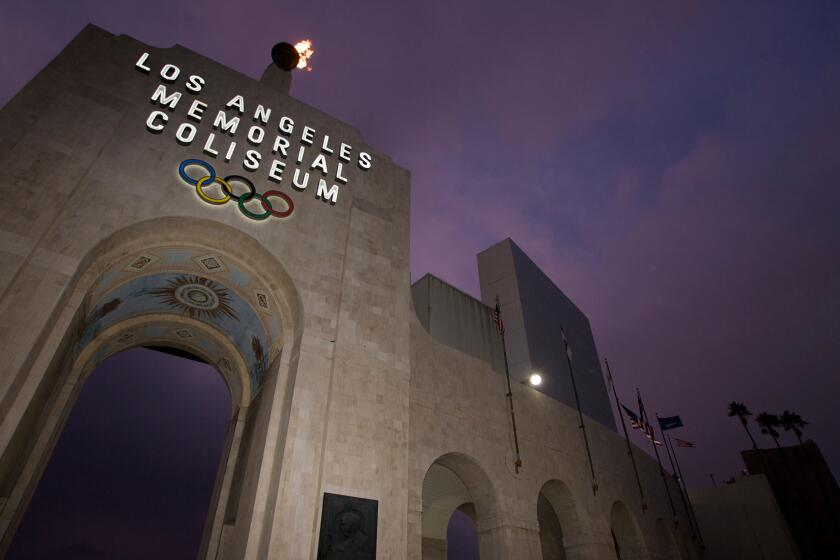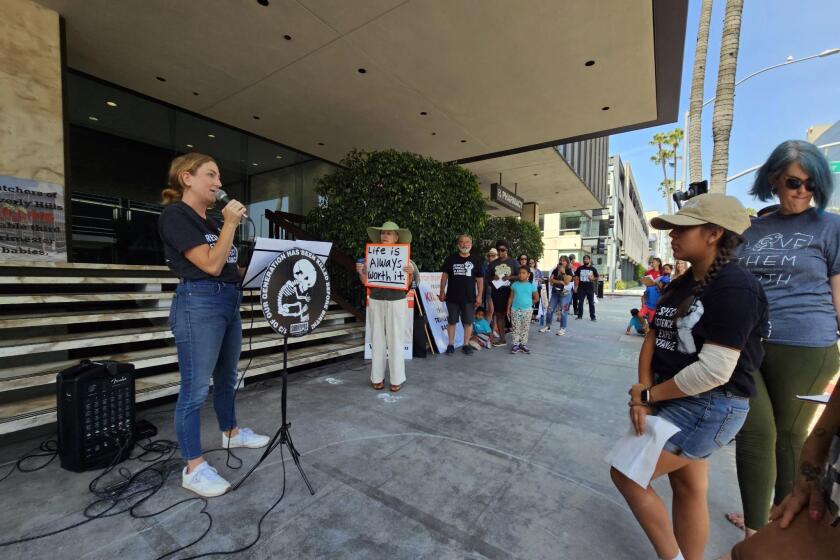A righteous beach baby
IT was bug-eyed and bowlegged, it buzzed like a nest of bumblebees and looked something like a bathtub on wheels. It was a tart of a car that made a statement — back in that bygone day when you could still make a smile your statement and people wouldn’t take you for loony.
The Meyers Manx dune buggy was born in 1964 in the garage of an apartment building a block from the seashore in Newport Beach.
It was an in-between kind of car — in between tailfins and hot rods. And it fit an in-between era. Jack Kennedy was killed a few months earlier while Bruce Meyers shaped a mock-up of the left front fender of his red-orange original. The Civil Rights movement was in tumultuous pitch. But Americans had not yet glimpsed the great shadow clouds of cynicism that lay on the horizon with the quagmire of Vietnam, the Watts riots and events to follow.
The worm hadn’t turned, not yet. It was a time when this part of California still meant — symbolically at least — beaches, boundless spaces and play. Perpetual gridlock was in the future, Bob’s Big Boy hadn’t been sold to a national chain, “Gilligan’s Island” debuted on the tube, the drive-in theater was a neighborhood fixture. If something was good, it wasn’t yet “awesome” but “righteous.”
Thus, the Manx dune buggy summed up a righteous moment in the spirit of Southern California. It never gave an inch to doubt.
“Fun, fun, fun,” sang the Beach Boys in their hit that year.
This was not a car with a design studio behind it. No suit-and-tie corporation bankrolled the venture. This was the sketch-pad creation of a man who perfectly fit this era, a free spirit in flip-flops, baggy trunks and Coppertone cologne.
Born in Los Angeles, Meyers knew nothing about barriers, he didn’t have a rule book. But he could surf. He could draw. He knew the dirt roads that wound into Baja, and he knew where the beach crowd partied. He was a surfboard glasser and a one-time boat builder who understood how to mold fiberglass. In Southern California in 1964, these were rich talents.
Actually, Meyers did not design the first dune buggy. Street cars with hand-built bodies were already lumbering over the Pismo Beach dunes when he took in the scene a year earlier. He wasn’t the first to use fiberglass for a car, either. But in a flight of imaginative fancy, he brought them together.
It was a sunny spring morning in Orange County when Manx No. 1 debuted on Pacific Coast Highway. With a souped-up, 50-horsepower, air-cooled motor, the car was zippy and limber. At the wheel, Meyers looked like an escapee from an arcade. His creation was all about whimsical lines and color, nothing about adornments. When passersby lifted their jaws off the ground, they laughed — not at this buggy, this thing that resembled a mutant frog with wheels or a fat surfboard melted over the chassis of a car, but with it. This same year, Rudi Gernreich cut the swimsuit in half, the Beatles let their hair grow, the discotheque arrived and so did “Dr. Strangelove.” People were ready to loosen up their thinking.
Meyers experimented by offering dune-buggy kits for $985. All you needed were the wheel assemblies and engine of a Volkswagen beetle, a set of baby moon hubcaps, a garage and tools. Then, the kit was simplified to bolt directly onto the floorpan of a VW and sold for a reduced price of $635.
Before long, the enterprise engaged 80 employees and 200 dealers.
Perhaps it was fitting that this quintessential Southern California car was inspired by the most innocent of fantasies: comics. Mickey Mouse and Andy Gump romped across the pages of newspapers in little cars with the big fat tires. Forty-two years before Hollywood’s animated film “Cars,” the Manx dune buggy was the closest thing you’d ever see to a machine that looked like it wanted to talk.
Curiously, this distinctive creation proved adaptable to the varying passions of its owners.
With a surfboard wedged in back and a transistor radio loose on the floor, the Manx was called a “beach buggy,” and it joined the Woodie as a symbolic party wagon of the California beach scene. It also touched off the high-performance off-road craze. Back in 1967, Meyers strapped on auxiliary tanks to carry 65 gallons of gasoline in his No. 1 and flew down the dirt roads between La Paz and Tijuana — yes, flew, and magazines of the time seemed inordinately delighted to show the Manx airborne at the crest of a hill.
Meyers bested the elapsed time record motorcyclists had set for the run through Mexico. He remembers the headline of a press release: “Buggy Bests Bikes in Baja.” That led to the Mexican 1000, later called the Baja 1000, the grandfather of all such road races.
In whatever incarnation, the dune buggy was as exposed as a golf cart. Back then, GPS might have stood for Get Plenty of Sun. With hindsight, we can measure the cultural transformation of four decades of motoring — from the extroverted driver’s seat of the dune buggy to the withdrawn, smoke-glass, air-conditioned compartments of today.
The popularity of the Manx reflected an era when working on cars was a middle-class pastime, handed down from father to son. The dune buggy was just about as simple a machine as could be, and many a Manx was a garage project for male members of the household.
By 1970, Meyers had sold 6,000 of his dune buggies and another 1,000 related models. Automotive writers called it one of the most influential cars of the age. Then after seven years, he closed the door on the 40,000-square-foot factory — driven out of business by an ever expanding plethora of copycats who produced cars that looked the same, or nearly so, and without Meyers’ overhead.
Eventually, 100,000 or so dune buggies of the style were sold in the U.S., and even Sears got into the cloning business with a model called the “Rascal.”
The inventor of the Manx spent 2 1/2 decades bitter and adrift. He built a house in Mexico and restored classic cars in Orange County. He didn’t want to hear the words “dune buggy.”
Then in the mid-1990s, Meyers was invited to Le Mans by the publisher of a group of French auto magazines. Interest in the car was still high in Europe. The fever created by the Manx circled back to reinfect its inventor.
He returned to establish a dune buggy club, which now has 3,000 members worldwide — most of them aging youngsters from the 1960s. He produced a limited-edition reprise of the Manx. And then he began designing a new Manxter dune buggy — a fancier, four-passenger version of the original, which can be powered either by a standard VW engine or, like Meyers’ personal car, a screaming 260-horsepower Subaru. Kits are priced from $5,200 to $7,500.
He is 80 now and lives in rural Valley Center, north of San Diego. He drives down to the beach once a week to play his guitar and smell the ocean air. He surrounds himself with memorabilia and marvels at the power of nostalgia.
“I’m still trying today to think why I did it,” he said. “And I don’t know why .All I know is that I couldn’t have created the Meyers Manx in Kansas.”
More to Read
Sign up for Essential California
The most important California stories and recommendations in your inbox every morning.
You may occasionally receive promotional content from the Los Angeles Times.














